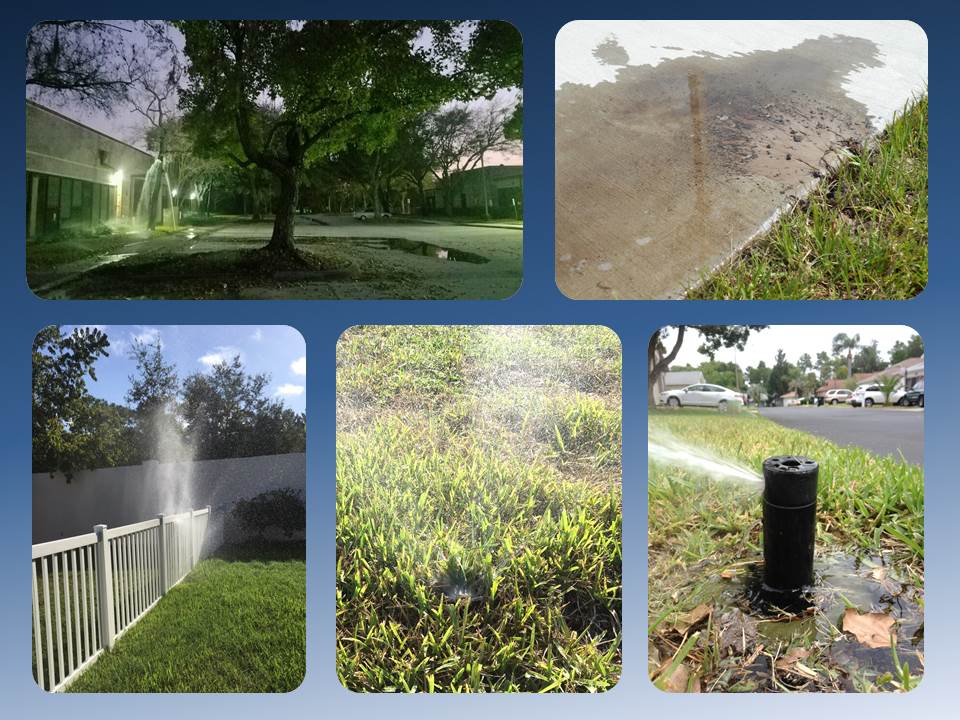It’s time for a sprinkler tune-up!
With another “dry season” approaching in central FL, it’s time to make sure your sprinkler system is putting water where it’s needed, when it’s needed…

So, if you’re a DIY person, get ready to run through your sprinklers… because here’s your sprinkler “wet-check” guide!
(NOTE: Even if you prefer to hire a pro, it’s still good to understand the basics of your system and its flaws… so read on!)
HOW TO USE THIS GUIDE: For each type of problem, I’ll briefly describe what it would look like (or sound like) in your landscape, and provide a few possible solutions. To help illustrate each issue, I’ve also included video clips* from the spring 2020 webinar, “Glorious Geysers & Pressure-Washing Plants.”
*(NOTE: Ignore the fact that the video thumbnails are all identical. Each clip is set to begin playing at the correct section of the video! Just pause the video after it finishes the current topic, and keep scrolling down the blog for the next sprinkler problem.)
PROBLEM: Misdirected heads
- LOOKS LIKE: You’re watering something other than your grass or landscape plants (i.e. watering the street, pathways, driveway, joggers, passing cars, etc…)
- POSSIBLE SOLUTIONS:
-
- Re-align head(s), increase/decrease spray radius, adjust angle – See links at the end of the post for tutorials on adjusting common types of heads.
- Replace nozzles w/ custom spray patterns (available for corners, angles, narrow curb strips, etc. – cheap & easy fix!!)
- PRO-TIP: Different brands use different thread patterns, so be sure to get the correct ones!
PROBLEM: Clogged heads
- LOOKS LIKE: The head pops up, but the spray is weak or nearly absent, WITHOUT water pooling around its base.
- POSSIBLE SOLUTIONS:
-
- Carefully unscrew the nozzle, remove debris, clean or replace the small filter.
- PRO-TIP #1: When removing a nozzle, be careful not to lose any small parts – springs, filters, etc.
- PRO-TIP #2: Be sure to re-check alignment AFTER replacing the head to avoid causing misdirected spray (see above).
- PRO-TIP #1: When removing a nozzle, be careful not to lose any small parts – springs, filters, etc.
- Carefully unscrew the nozzle, remove debris, clean or replace the small filter.
PROBLEM: Obstructed spray pattern
Obstructed sprays – Option 1
Obstructed sprays – Option 2
- SOUNDS LIKE: You’re pressure-washing your plant, fence, etc.
- LOOKS LIKE: Uneven coverage. Water is prevented from reaching target. Part of the zone is receiving much less water than the rest. (Verify with a “catch-can” test)
- OPTION 1: An object (i.e. shrub, new fence, etc.) is blocking spray pattern.
- OPTION 2: Heads are too low. Rather than spraying water across the entire lawn, the head is just “pressure-washing” the nearest blades of grass. Meanwhile, just a few feet away, the turf receives only a minimal mist…
- POSSIBLE SOLUTIONS:
- IF OBSTRUCTED BY OBJECT (i.e. shrub, fence, etc.) – Relocate the existing head(s) – OR – cap off existing head(s) and add new ones in better locations.
- IF BLOCKED BY TURF HEIGHT – Install taller heads. For example, replace a 4″ pop-up with a 6″ pop-up.
- PRO TIP: This modification may require a flexible connector or ‘swing joint’ to keep the retracted head flush with ground-level.
-
- NOTE! After repairs, be sure to perform another “catch-can” test to ensure even coverage throughout the zone.
PROBLEM: Leaking seals
-
-
- LOOKS LIKE:
- Water pools around the base of the sprinkler. (Example)
- Spray pressure seems weak.
- Head only pops up part-way, or not at all.
- LOOKS LIKE:
-
-
-
- POSSIBLE SOLUTIONS:
-
- “Exercise” the head up and down a few times. (Sometimes, after non-use, the seal is just stiff…)
- Check if turf overgrowth is preventing full extension of head. If needed, cut away some turf to allow head to pop up freely.
- If unable to resolve, it’s probably easier to replace the head than try to repair the seal.
- PRO-TIP: Be sure to match spray pattern & precipitation rate.
-
PROBLEM: Trapped heads
- LOOKS LIKE:
- Part of the zone is receiving much less water than the rest (Verify with a “catch-can” test)
- A head “should be there,” but isn’t.
- SOUNDS LIKE: Odd gurgles, squeaks, squeals (or sometimes silent…)
- POSSIBLE SOLUTIONS: You’ll need to “rescue” the trapped head(s) from below turf stolons by cutting away turf overgrowth. To prevent turf overgrowth from recurring, consider adding those sprinkler “doughnut” thingies…
PROBLEM: Missing nozzle / missing head / broken pipe
- LOOKS LIKE:
- “Old Faithful” is erupting in your yard.
- Water is pooling / gushing / gurgling. (Example)
- Other heads in the zone have low pressure / low output
- POSSIBLE SOLUTIONS:
-
- Locate / repair broken head (or pipe, etc.)
- If no longer needed, consider capping off the broken head
- PRO TIP: Be sure to match spray patterns & precipitation rates!
PROBLEM: Broken drip hoses, etc.
- LOOKS LIKE:
- POSSIBLE SOLUTIONS:
-
- Repair drip tubing with appropriate “goof plugs” or other fittings as needed.
PRO TIP: If trees and/or shrubs are well-established (greater than 5+ years old), determine whether drip irrigation is still necessary. Drought tolerant trees and shrubs may be self sufficient once fully established, reducing or eliminating the need for regular watering except in times of prolonged extreme drought.
PROBLEM: Miscellaneous leaks – backflow devices, etc.
LOOKS LIKE: Depends on the specific source of the problem. Examples of clues to look for could include:
- Unusual slimy, wet growth on above-ground pipes, backflow devices, etc.
- Water meter slowly spinning – Learn how to use your water meter as a leak-detecting tool HERE
- Water bills increasing without other explanation
PRO-TIPS
While you’re doing your checks, here are a few simple adjustments you can make to fine-tune your system and maximize your water-efficiency! I’ve included several more helpful links about adjusting common types of heads at the end of the post.
REMEMBER – There’s a sprinkler for every situation – “right head, right place” – don’t mix your heads!
Other online tutorials – Adjusting heads
The following online tutorials demonstrate how to adjust several common types of spray and rotor heads. (Inclusion does not represent endorsement of specific brands/products):
- Adjusting pop-up spray heads:
- Adjusting rotors:
What about controllers, timers, sensors…?
Stay tuned! We’ll cover the controller & sensors in upcoming posts! Follow @PascoExt on Twitter & Facebook so you never miss a post!
A quick note about “mixed heads” (sprays/rotors)
If you’re a long-time reader of my blog, you know that either too much or too little water can cause BIG problems… Sprays and rotors apply water at VERY different rates. When sprays and rotors are combined in a single zone, usually, something is either receiving too much water, or too little. If you’ve got mixed heads, this video from UF/IFAS Extension Miami-Dade discusses an easy option for retrofitting spray heads with “multi-stream” rotating heads.
#SidewalksDontGrow #JustWetYourPlants
About the Author: As the Florida Friendly Landscaping (FFL) Program Coordinator in Pasco County, I work to help ensure that our community is full of vibrant landscapes that DON’T require a lot of water, fertilizer, and pesticides to look their best. Through an innovative collaboration with Pasco County Utilities, I also provide targeted on-site troubleshooting outreach to help those individuals and communities identified as high water users. My motto is – “Less guesswork, better landscapes.” I can be reached at fgaldo@ufl.edu
Thirsty for more FFL knowledge? Don’t forget to follow us on Facebook & Twitter!
Have a question, or an idea for a future post? Let me know at fgaldo@ufl.edu or leave a comment below.
About UF/IFAS Extension: UF/IFAS Extension serves as a source of non-biased, research-based information for the residents, businesses, and communities of Florida, providing educational materials and programs for adults and youth. We proudly “provide solutions for your life.”
(Not in Pasco County? Not a problem! Click here to find your local UF/IFAS Extension office!)
UF/IFAS Extension Is An Equal Opportunity Institution.
 0
0






